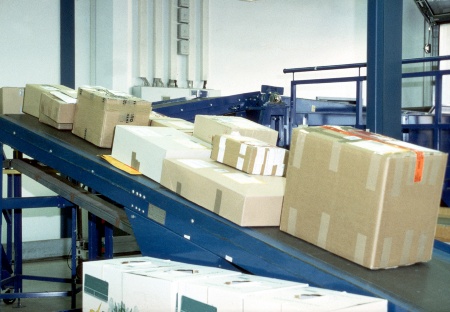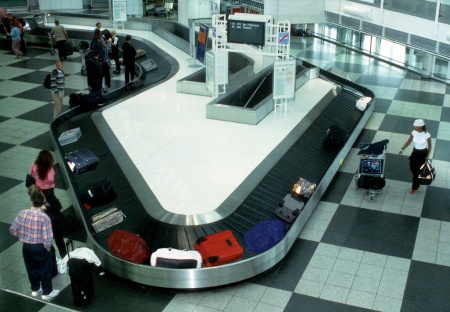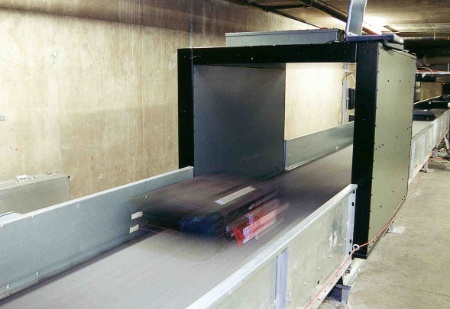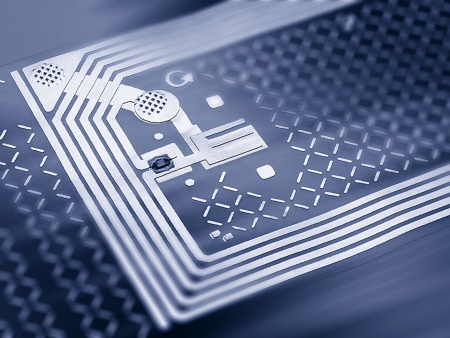Barcodes Watch Out! New RFID Chips from Infineon Read 500 Smart Labels Simultaneously
Munich, Germany December 2, 2003 Infineon Technologies (FSE/NYSE: IFX) is expanding its RFID (Radio Frequency Identification) solutions portfolio. Its new PJM (Phase Jitter Modulation) chips can be read and written at high speed. They boast a large storage capacity and extensive security functions. Unlike current RFID solutions, PJM chips are suitable for simultaneous contactless electronic identification of several hundred objects or very fast-moving objects. The focus is on applications for transport logistics, goods tracking and dispatch, baggage handling at airports, and for mail and courier services. Infineon co-developed the chip with Australian company Magellan Technology on the basis of Magellans PJM technology.
Infineon is launching two PJM products: ItemTag and StackTag. The PJM ItemTag® is designed for applications in which individual objects identified by RFID labels travel past the reader at high speed and are captured at the highest possible data rates. Example applications include fast stocktaking during delivery and shipment of goods pallets or baggage handling at airports. The PJM StackTag® can be used wherever there is a requirement for reliable identification of up to 500 tightly packed or stacked objects courier parcels, for example. Previously, antennas lying on top of one another resulted in signal collisions and read errors, so simultaneous readout was considered impossible for physical reasons.
The PJM technology optimized for logistics applications is capable of reliably identifying, reading and writing up to 500 electronic labels, regardless of their orientation, in less than a second. It copes with conveyor belt speeds of approx. 15 kilometers per hour (4 meters per second). With existing RFID technology, identification performance tops out at 30 electronic labels per second, equivalent to a speed of half a meter per second.
Compared with existing RFID devices, PJM chips are roughly 25 times faster at reading and writing thanks to innovative design features such as FTDMA (Frequency and Time Division Multiple Access) and multichannel frequency hopping technology. Using the 8-channel frequency hopping method, the new PJM chips support fast and efficient anti-collision. Constant switching between eight different radio channels increases the read speed and ensures positive identification even in mass throughput applications. Data rates up to 848 kbit/s are possible. RFID chips conforming to ISO 15693 support max. 26.48 kbit/s. The PJM chips are designed for the new ISO 18000-3 Mode 2 standard.
The 10-Kbit memory is equivalent to about two DIN A4 pages of simple text. It can be partitioned into multiple sectors to which only authorized persons have read or write access. Special encryption methods prevent unauthorized access to the protected data.
With its PJM chips, Infineon is addressing extremely powerful RFID applications with the aim of providing total solutions, starting from the chips and the system architecture through partner coordination to full system implementation, explained Bodo Ischebeck, Senior Director of Ident Solutions at Infineon Technologies. Infineon is cooperating closely with Magellan Technology on the design, planning and introduction of PJM technology in logistics applications.
Electronic identification plays a significant economic role in light of the increasing trend in industry to produce highly individualized products and at the same time achieve capital expenditure savings through efficient inventory management and intelligent logistics. Industrial applications in logistics and production are therefore regarded as the strongest growth sector in the RIFD chips market. According to figures published by market researchers for Allied Biz Intelligence, the chips are expected to account for more than 50 percent of the total RFID transponder market with global sales of 1.1 billion euros by as early as 2007.
Infineons PJM chips are manufactured using a 0.25-micron CMOS production process and complement Infineons portfolio of 13.56-MHz RFID solutions.
The chips can be read and rewritten more than 100,000 times. Depending on the system configuration, the ICs are programmable up to a distance of 120 cm.
Development samples of the PJM chips will be available by the end of 2003, with volume production expected to come on stream in the 1st quarter of 2004. The ICs will be shipped as unsawn wafers or inlays on a PET carrier with aluminum antenna.
For technical information on Magellan Technologys PJM technology please go to: www.magtech.com.au
Infineon is launching two PJM products: ItemTag and StackTag. The PJM ItemTag® is designed for applications in which individual objects identified by RFID labels travel past the reader at high speed and are captured at the highest possible data rates. Example applications include fast stocktaking during delivery and shipment of goods pallets or baggage handling at airports. The PJM StackTag® can be used wherever there is a requirement for reliable identification of up to 500 tightly packed or stacked objects courier parcels, for example. Previously, antennas lying on top of one another resulted in signal collisions and read errors, so simultaneous readout was considered impossible for physical reasons.
The PJM technology optimized for logistics applications is capable of reliably identifying, reading and writing up to 500 electronic labels, regardless of their orientation, in less than a second. It copes with conveyor belt speeds of approx. 15 kilometers per hour (4 meters per second). With existing RFID technology, identification performance tops out at 30 electronic labels per second, equivalent to a speed of half a meter per second.
Compared with existing RFID devices, PJM chips are roughly 25 times faster at reading and writing thanks to innovative design features such as FTDMA (Frequency and Time Division Multiple Access) and multichannel frequency hopping technology. Using the 8-channel frequency hopping method, the new PJM chips support fast and efficient anti-collision. Constant switching between eight different radio channels increases the read speed and ensures positive identification even in mass throughput applications. Data rates up to 848 kbit/s are possible. RFID chips conforming to ISO 15693 support max. 26.48 kbit/s. The PJM chips are designed for the new ISO 18000-3 Mode 2 standard.
The 10-Kbit memory is equivalent to about two DIN A4 pages of simple text. It can be partitioned into multiple sectors to which only authorized persons have read or write access. Special encryption methods prevent unauthorized access to the protected data.
With its PJM chips, Infineon is addressing extremely powerful RFID applications with the aim of providing total solutions, starting from the chips and the system architecture through partner coordination to full system implementation, explained Bodo Ischebeck, Senior Director of Ident Solutions at Infineon Technologies. Infineon is cooperating closely with Magellan Technology on the design, planning and introduction of PJM technology in logistics applications.
Electronic identification plays a significant economic role in light of the increasing trend in industry to produce highly individualized products and at the same time achieve capital expenditure savings through efficient inventory management and intelligent logistics. Industrial applications in logistics and production are therefore regarded as the strongest growth sector in the RIFD chips market. According to figures published by market researchers for Allied Biz Intelligence, the chips are expected to account for more than 50 percent of the total RFID transponder market with global sales of 1.1 billion euros by as early as 2007.
Infineons PJM chips are manufactured using a 0.25-micron CMOS production process and complement Infineons portfolio of 13.56-MHz RFID solutions.
The chips can be read and rewritten more than 100,000 times. Depending on the system configuration, the ICs are programmable up to a distance of 120 cm.
Availability
Development samples of the PJM chips will be available by the end of 2003, with volume production expected to come on stream in the 1st quarter of 2004. The ICs will be shipped as unsawn wafers or inlays on a PET carrier with aluminum antenna.
For technical information on Magellan Technologys PJM technology please go to: www.magtech.com.au
About Infineon
Infineon Technologies AG, Munich, Germany, offers semiconductor and system solutions for the automotive and industrial sectors, for applications in the wired communications markets, secure mobile solutions as well as memory products. With a global presence, Infineon operates in the US from San Jose, CA, in the Asia-Pacific region from Singapore and in Japan from Tokyo. In the fiscal year 2003 (ending September), the company achieved sales of Euro 6.15 billion with about 32,300 employees worldwide. Infineon is listed on the DAX index of the Frankfurt Stock Exchange and on the New York Stock Exchange (ticker symbol: IFX). Further information is available at www.infineon.com.
Infineon and the stylized Infineon Technologies design are trademarks and service marks of Infineon Technologies AG. Any other trademarks appearing herein are the property of their respective owners.
Video material can be downloaded from www.thenewsmarket.com.
Information Number
INFSMS200312.019
Press Photos
-
 Optimized for logistics applications, the "PJM ItemTag®" chips are used for fast-moving separate items on, say, conveyor belts or in parcel sorting system.Press Photo
Optimized for logistics applications, the "PJM ItemTag®" chips are used for fast-moving separate items on, say, conveyor belts or in parcel sorting system.Press PhotoJPG | 525 kb | 1535 x 1063 px
Press PhotoJPG | 11 kb | 160 x 111 px
-
 Baggage claim area at the airport.Press Photo
Baggage claim area at the airport.Press PhotoJPG | 559 kb | 1535 x 1063 px
Press PhotoJPG | 559 kb | 1535 x 1063 px
-
 Infineons PJM (Phase Jitter Modulation) chips are suitable for contactless electronic identification of fast-moving objects, such as baggage handling at airports. Here: baggage claim area. Photo: Magellan TechnologyPress Photo
Infineons PJM (Phase Jitter Modulation) chips are suitable for contactless electronic identification of fast-moving objects, such as baggage handling at airports. Here: baggage claim area. Photo: Magellan TechnologyPress PhotoJPG | 59 kb | 589 x 405 px
Press PhotoJPG | 7 kb | 160 x 110 px
-
 RFID tag with chip and antenna; size 7.5 cm x 4.5 cm.Press Foto
RFID tag with chip and antenna; size 7.5 cm x 4.5 cm.Press FotoJPG | 275 kb | 1291 x 969 px
Press FotoJPG | 11 kb | 160 x 120 px
